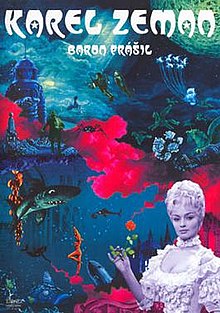
Karel Zeman’s 1961 surrealist masterpiece The Fabulous Baron Munchausen is one of the more bizarre entries in film, with its fanciful story, kaleidoscopic colors, and animation/live action mix. The logical musical accompaniment would be something as equally odd and avantgarde. Instead, famed Czech composer Zdeněk Liška’s score provides a subtle counterpoint.
The Fabulous Baron Munchausen is similar to a silent film, with its stark dialogue and minimal sound effects. Liška’s score fills in the gaps, at times even entirely replicating and replacing diegetic sounds. For instance, in a clash amongst a fleet of Turkish warships, Liška creates a rousing battle suite that includes arcing slide played synchronously with the visible flight path of cannonball fire. Image and music become so intertwined that they reach a symbiotic relationship unheard of since the silent age.
Liška uses the film’s bizarre style as an excuse to experiment with different musical genres. Most notably is his use of very early electronic music that would be further refined by the likes of Wendy Carlos in a Clockwork Orange. Unlike contemporary styles like musique concrete that used this new electronic instrumentation in experimental ways, Liška simply uses electronic music as a substitute for more traditional film scoring instrumentation. The sound may have been novel, but Liška’s film scoring techniques remained familiar. This combination complements the film’s madness while simultaneously keeping it from imploding in its own insanity.
